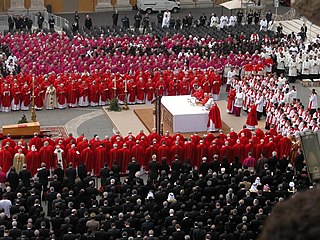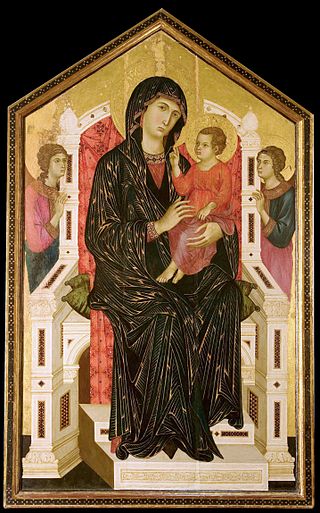
The College of Cardinals, more formally called the Sacred College of Cardinals, is the body of all cardinals of the Catholic Church. As of 28 October 2024, there are 233 cardinals, of whom 121 are eligible to vote in a conclave to elect a new pope. Cardinals are appointed by the pope for life but eligibility to vote ceases at the age of 80.

The Catholic Church, also known as the Roman Catholic Church, is the largest Christian church, with 1.28 to 1.39 billion baptized Catholics worldwide as of 2024. It is among the world's oldest and largest international institutions and has played a prominent role in the history and development of Western civilization. The church consists of 24 sui iuris churches, including the Latin Church and 23 Eastern Catholic Churches, which comprise almost 3,500 dioceses and eparchies around the world. The pope, who is the bishop of Rome, is the chief pastor of the church. The Diocese of Rome, known as the Holy See, is the central governing authority of the church. The administrative body of the Holy See, the Roman Curia, has its principal offices in Vatican City, which is a small, independent city-state and enclave within the city of Rome, of which the pope is head of state.
The hierarchy of the Catholic Church consists of its bishops, priests, and deacons. In the ecclesiological sense of the term, "hierarchy" strictly means the "holy ordering" of the church, the Body of Christ, so to respect the diversity of gifts and ministries necessary for genuine unity.
The Secretariat of State is the oldest dicastery in the Roman Curia, the central papal governing bureaucracy of the Catholic Church. It is headed by the Cardinal Secretary of State and performs all the political and diplomatic functions of the Holy See. The Secretariat is divided into three sections: the Section for General Affairs, the Section for Relations with States, and, since 2017, the Section for Diplomatic Staff.
Romano Pontifici eligendo was the apostolic constitution governing the election of popes that was promulgated by Pope Paul VI on 1 October 1975. It instituted a number of far-reaching reforms in the process of electing popes. It set the maximum number of electors at 120 and restated in a more formal context the rule he had already instituted that cardinals over the age of 80 not participate in electing a pope.
An episcopal conference, often also called a bishops’ conference or conference of bishops, is an official assembly of the bishops of the Catholic Church in a given territory. Episcopal conferences have long existed as informal entities. The first assembly of bishops to meet regularly, with its own legal structure and ecclesial leadership function, is the Swiss Bishops' Conference, which was founded in 1863. More than forty episcopal conferences existed before the Second Vatican Council. Their status was confirmed by the Second Vatican Council and further defined by Pope Paul VI's 1966 motu proprio, Ecclesiae sanctae.
The papal household or pontifical household, called until 1968 the Papal Court, consists of dignitaries who assist the pope in carrying out particular ceremonies of either a religious or a civil character.

Mar Ignatius Gabriel I Tappouni was a leading prelate of the Syriac Catholic Church. He served as Patriarch of Antioch from 1929 to 1968, and was elevated to the cardinalate in 1935.

In the Catholic Church, a bishop is an ordained minister who holds the fullness of the sacrament of holy orders and is responsible for teaching doctrine, governing Catholics in his jurisdiction, sanctifying the world and representing the Church. Catholics trace the origins of the office of bishop to the apostles, who it is believed were endowed with a special charism and office by the Holy Spirit at Pentecost. Catholics believe this special charism and office has been transmitted through an unbroken succession of bishops by the laying on of hands in the sacrament of holy orders.

Mariological papal documents have been a major force that has shaped Roman Catholic Mariology over the centuries. Mariology is developed by theologians on the basis not only of Scripture and Tradition but also of the sensus fidei of the faithful as a whole, "from the bishops to the last of the faithful", and papal documents have recorded those developments, defining Marian dogmas, spreading doctrines and encouraging devotions within the Catholic Church.

The 1983 Code of Canon Law, also called the Johanno-Pauline Code, is the "fundamental body of ecclesiastical laws for the Latin Church". It is the second and current comprehensive codification of canonical legislation for the Latin Church of the Catholic Church. The 1983 Code of Canon Law was promulgated on 25 January 1983 by John Paul II and took legal effect on the First Sunday of Advent 1983. It replaced the 1917 Code of Canon Law which had been promulgated by Benedict XV on 27 May 1917.
Pope Paul VI's reform of the Roman Curia was accomplished through a series of decrees beginning in 1964, principally through the apostolic constitution Regimini Ecclesiae universae issued on 15 August 1967.
An apostolic exhortation is a magisterial document written by the pope. Some experts regard it as third in importance among papal documents, after apostolic constitutions and encyclicals. Exhortations generally encourage a particular virtue or activity. Apostolic exhortations are frequently issued following a Synod of Bishops, in which case they are known as post-synodal apostolic exhortations. They do not define Church doctrine and are not considered legislative.
The history of the Roman Curia, the administrative apparatus responsible for managing the affairs of the Holy See and the Catholic Church, can be traced to the 11th century when informal methods of administration began to take on a more organized structure and eventually a bureaucratic form. The Curia has undergone a series of renewals and reforms, including a major overhaul following the loss of the Papal States, which fundamentally altered the range and nature of the Curia's responsibilities, removing many of an entirely secular nature.
Evangelii nuntiandi is an apostolic exhortation issued on 8 December 1975 by Pope Paul VI on the theme of Catholic evangelization. The title, taken from the opening words of the original Latin text, means "in proclaiming the Gospel". It affirms the role of every Christian, not only ordained ministers, priests, and deacons, or religious, or professional church staff, in spreading the Gospel of Jesus Christ.
The new evangelization is the particular process by which baptized members of the Catholic Church express the general Christian call to evangelization.
The Catholic Church utilizes the oldest continuously functioning legal system in the West, much later than Roman law but predating the evolution of modern European civil law traditions. The history of Latin canon law can be divided into four periods: the jus antiquum, the jus novum, the jus novissimum and the Code of Canon Law. In relation to the Code, history can be divided into the jus vetus and the jus novum. Eastern canon law developed separately.
In the Catholic Church, collegiality refers to "the Pope governing the Church in collaboration with the bishops of the local Churches, respecting their proper autonomy." In the early church the popes sometimes exercised moral authority rather than administrative power, and that authority was not exercised extremely often; regional churches elected their own bishops, resolved disputes in local synods, and only felt the need to appeal to the Pope under special circumstances.
Christus vivit is a post-synodal apostolic exhortation of Pope Francis, written in response to the Fifteenth Ordinary General Assembly of the Synod of Bishops, on young people, faith and vocational discernment, held from 3 to 28 October 2018.

The 16th Ordinary General Assembly of the Synod of Bishops, commonly referred to as the Synod on Synodality, was a Synod of Bishops of the Catholic Church which concluded 27 October 2024 and has as its theme "For a synodal Church: communion, participation and mission". It has been described as the culmination of Pope Francis's papacy and the most important event in the Church since the Second Vatican Council.







